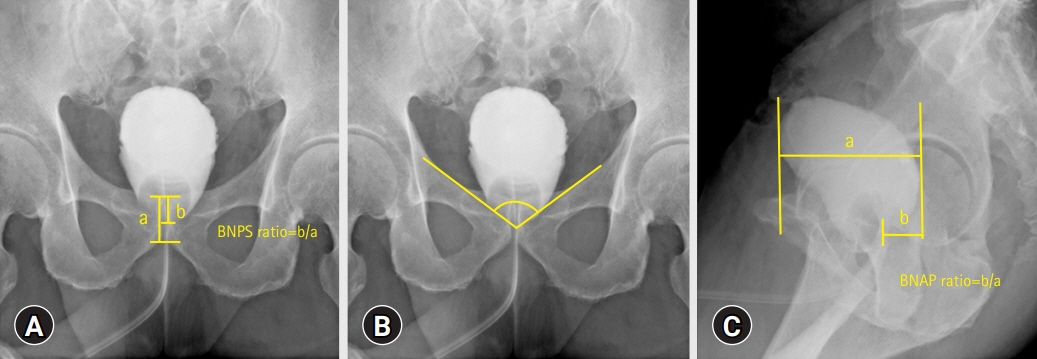J Yeungnam Med Sci.
2023 Jul;40(3):252-258. 10.12701/jyms.2022.00311.
Novel cystography parameter to predict early recovery from urinary continence after radical prostatectomy for prostate cancer: a retrospective study
- Affiliations
-
- 1Department of Urology, Yeungnam University College of Medicine, Daegu, Korea
- KMID: 2544585
- DOI: http://doi.org/10.12701/jyms.2022.00311
Abstract
- Background
The purpose of this study was to investigate whether postoperative cystography findings can predict early and long-term recovery from incontinence after radical prostatectomy (RP), compared with the other cystography parameters.
Methods
I retrospectively reviewed 118 patients who underwent robot-assisted RP (RARP) for localized prostate cancer at single institution between January 2016 and April 2021. One hundred and seven patients were included in the study. Postoperative cystography was routinely performed 7 days after surgery. The bladder neck to pubic symphysis ratio, vesicourethral angle, and bladder neck anteroposterior length (BNAP) ratio (the bladder neck-posterior margin distances divided by the anteroposterior lengths) were evaluated. Continence was defined as cessation of pad use. The association between these variables and urinary incontinence was also analyzed.
Results
The urinary incontinence recovery rates 1, 3, 6, and 12 months after RARP were 43.92%, 66.35%, 87.85%, and 97.19%, respectively. Multivariate logistic regression analysis demonstrated that a lower BNAP ratio and wider vesicourethral angle were significantly associated with continence restoration at 1, 3, and 6 months after surgery. In addition, in terms of days of pad usage, lower BNAP ratio, wider vesicourethral angle, and bladder neck preservation were significantly associated with recovery from urinary incontinence within 12 months as assessed by Cox proportional hazard analysis.
Conclusion
This study demonstrated that vesicourethral angle and BNAP ratio were independent predictors of early recovery from post-prostatectomy incontinence. I suggest that both the sagittal and coronal views of postoperative cystography help anticipate early continence restoration after RARP.
Figure
Reference
-
References
1. Hammerer P, Huland H. Urodynamic evaluation of changes in urinary control after radical retropubic prostatectomy. J Urol. 1997; 157:233–6.2. Leach GE, Trockman B, Wong A, Hamilton J, Haab F, Zimmern PE. Post-prostatectomy incontinence: urodynamic findings and treatment outcomes. J Urol. 1996; 155:1256–9.3. Walz J, Burnett AL, Costello AJ, Eastham JA, Graefen M, Guillonneau B, et al. A critical analysis of the current knowledge of surgical anatomy related to optimization of cancer control and preservation of continence and erection in candidates for radical prostatectomy. Eur Urol. 2010; 57:179–92.4. Srivastava A, Chopra S, Pham A, Sooriakumaran P, Durand M, Chughtai B, et al. Effect of a risk-stratified grade of nerve-sparing technique on early return of continence after robot-assisted laparoscopic radical prostatectomy. Eur Urol. 2013; 63:438–44.5. Freire MP, Weinberg AC, Lei Y, Soukup JR, Lipsitz SR, Prasad SM, et al. Anatomic bladder neck preservation during robotic-assisted laparoscopic radical prostatectomy: description of technique and outcomes. Eur Urol. 2009; 56:972–80.6. Rocco F, Carmignani L, Acquati P, Gadda F, Dell'Orto P, Rocco B, et al. Early continence recovery after open radical prostatectomy with restoration of the posterior aspect of the rhabdosphincter. Eur Urol. 2007; 52:376–83.7. Mendoza PJ, Stern JM, Li AY, Jaffe W, Kovell R, Nguyen M, et al. Pelvic anatomy on preoperative magnetic resonance imaging can predict early continence after robot-assisted radical prostatectomy. J Endourol. 2011; 25:51–5.8. Coakley FV, Eberhardt S, Kattan MW, Wei DC, Scardino PT, Hricak H. Urinary continence after radical retropubic prostatectomy: relationship with membranous urethral length on preoperative endorectal magnetic resonance imaging. J Urol. 2002; 168:1032–5.9. Olgin G, Alsyouf M, Han D, Li R, Lightfoot M, Smith D, et al. Postoperative cystogram findings predict incontinence following robot-assisted radical prostatectomy. J Endourol. 2014; 28:1460–3.10. Sugi M, Kinoshita H, Yoshida T, Taniguchi H, Mishima T, Yoshida K, et al. The narrow vesicourethral angle measured on postoperative cystography can predict urinary incontinence after robot-assisted laparoscopic radical prostatectomy. Scand J Urol. 2018; 52:151–6.11. Rocco B, Gregori A, Stener S, Santoro L, Bozzola A, Galli S, et al. Posterior reconstruction of the rhabdosphincter allows a rapid recovery of continence after transperitoneal videolaparoscopic radical prostatectomy. Eur Urol. 2007; 51:996–1003.12. Jeong SJ, Yi J, Chung MS, Kim DS, Lee WK, Park H, et al. Early recovery of urinary continence after radical prostatectomy: correlation with vesico-urethral anastomosis location in the pelvic cavity measured by postoperative cystography. Int J Urol. 2011; 18:444–51.13. Kageyama S, Yoshida T, Nagasawa M, Kubota S, Tomita K, Kobayashi K, et al. The location of the bladder neck in postoperative cystography predicts continence convalescence after radical prostatectomy. BMC Urol. 2018; 18:52.14. Shao IH, Chou CY, Huang CC, Lin CF, Chang YH, Tseng HJ, et al. A specific cystography pattern can predict postprostatectomy incontinence. Ann Surg Oncol. 2015; 22(Suppl 3):S1580–6.15. Nishio K, Soh S, Syukuya T, Sato R, Sadaoka Y, Iwahata T, et al. Role of male pelvic floor muscles and anterior fibromuscular stroma in males on α(1)-blocker treatment: a magnetic resonance imaging study. Int J Urol. 2014; 21:724–7.16. Kwon SY. Association between cystographic anastomotic urinary leakage following retropubic radical prostatectomy and early urinary incontinence. Yeungnam Univ J Med. 2021; 38:142–7.17. Petros PE, Woodman PJ. The integral theory of continence. Int Urogynecol J Pelvic Floor Dysfunct. 2008; 19:35–40.18. Reeves F, Preece P, Kapoor J, Everaerts W, Murphy DG, Corcoran NM, et al. Preservation of the neurovascular bundles is associated with improved time to continence after radical prostatectomy but not long-term continence rates: results of a systematic review and meta-analysis. Eur Urol. 2015; 68:692–704.
- Full Text Links
- Actions
-
Cited
- CITED
-
- Close
- Share
- Similar articles
-
- The Effectiveness of Cystography-Measured Bladder Neck Elevation at Predicting the Return of Continence After Robot-Assisted Radical Prostatectomy
- Association between cystographic anastomotic urinary leakage following retropubic radical prostatectomy and early urinary incontinence
- The Role of Retrograde Urethrography as a Predictor of Early Recovery of Urinary Continence after Radical Retropubic Prostatectomy
- Effect of Posterior Urethral Reconstruction (PUR) in Early Recovery of Urinary Continence after Robotic-Assisted Radical Prostatectomy
- Radical Prostatectomy



